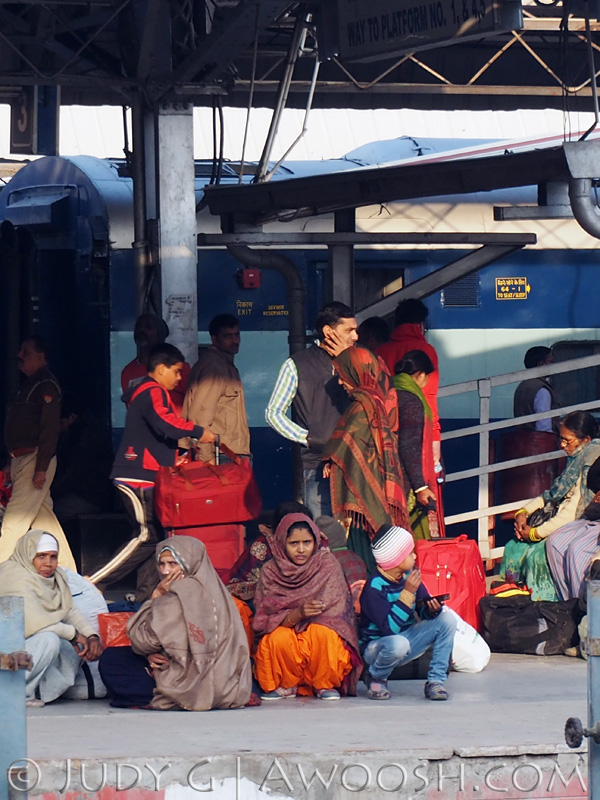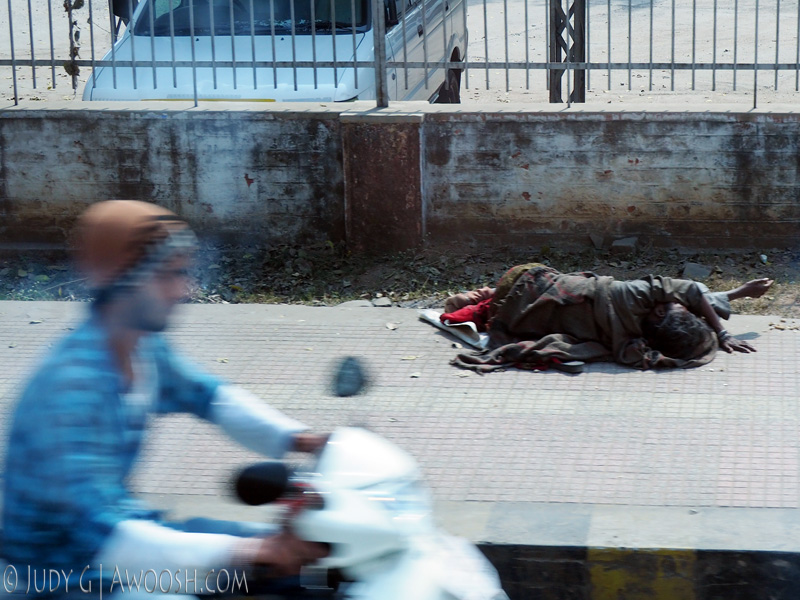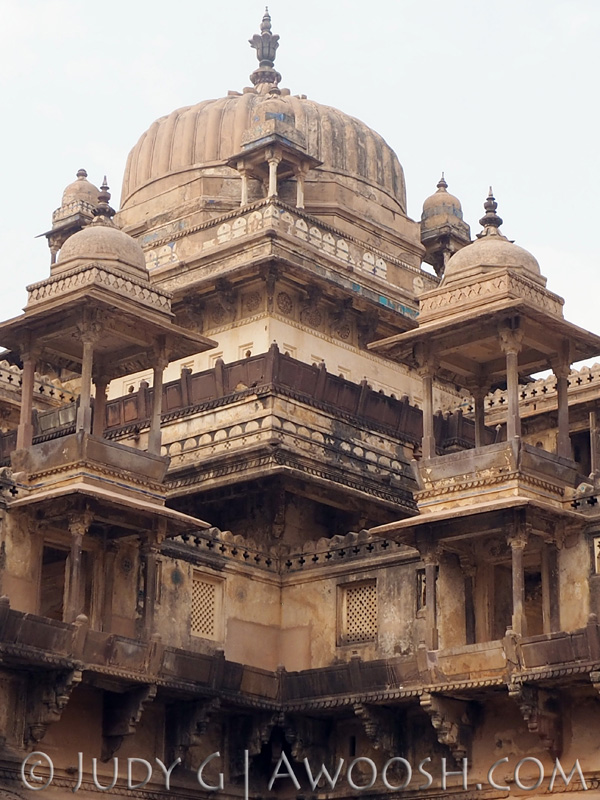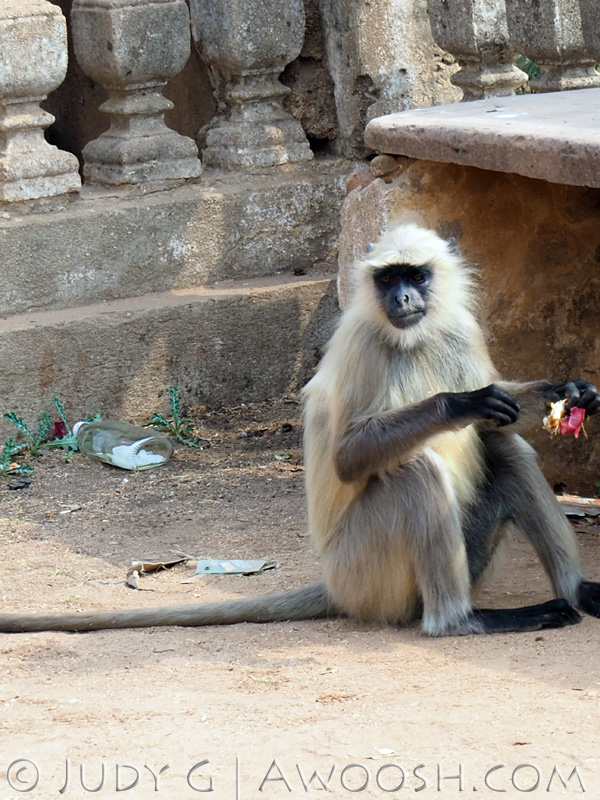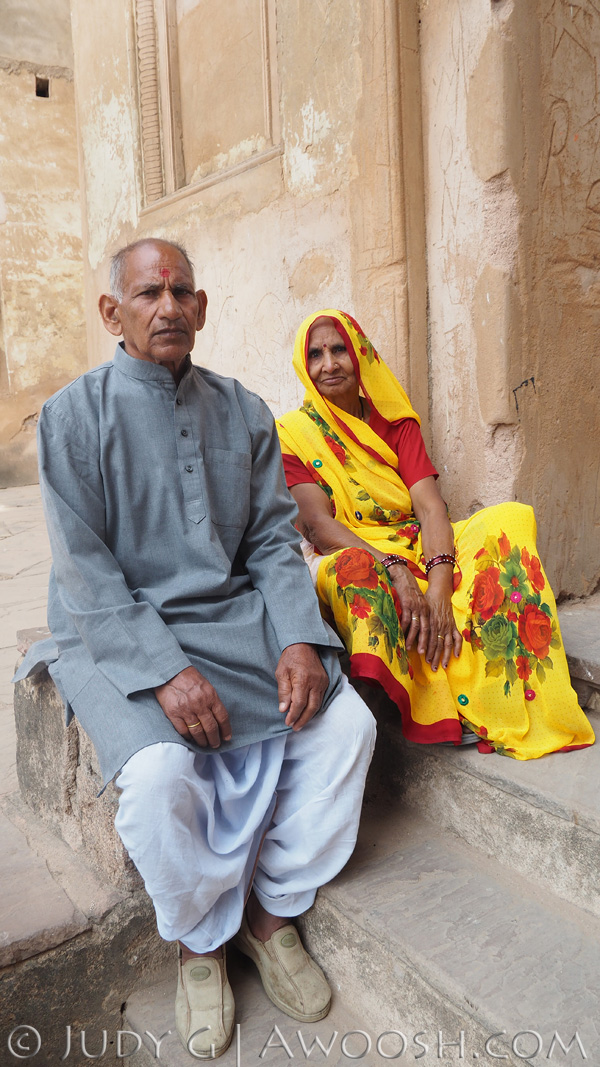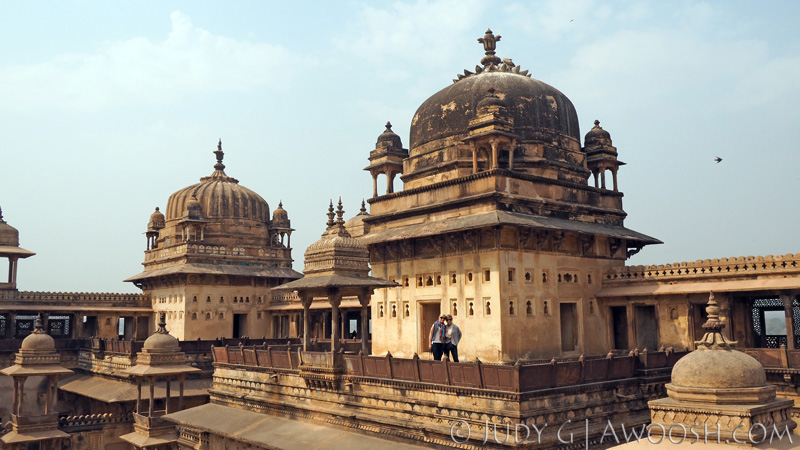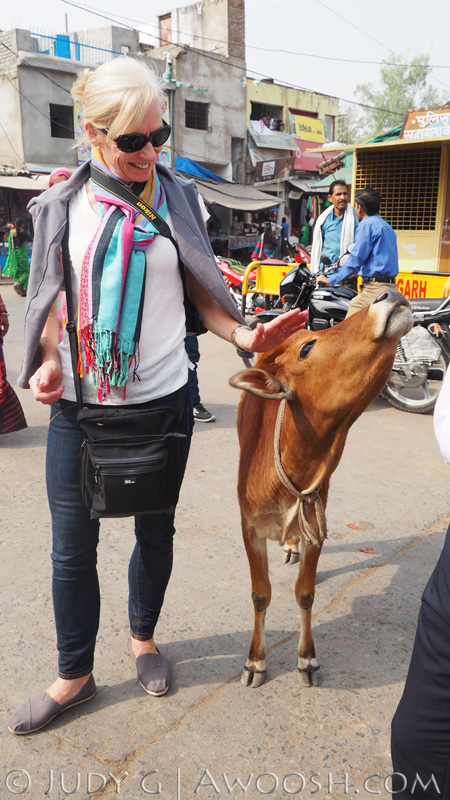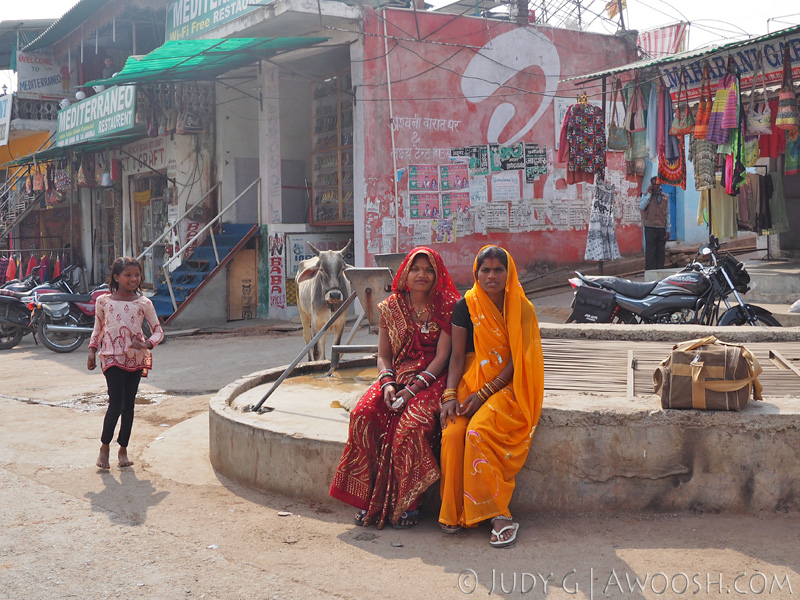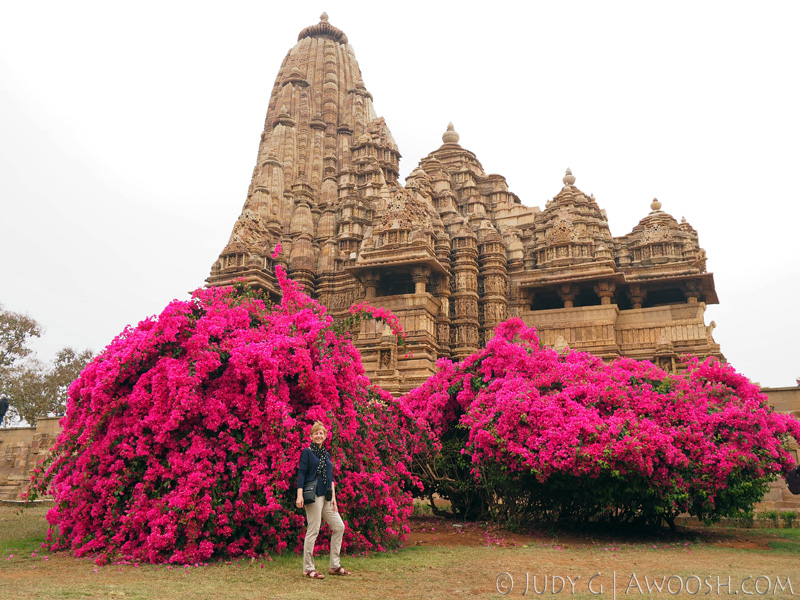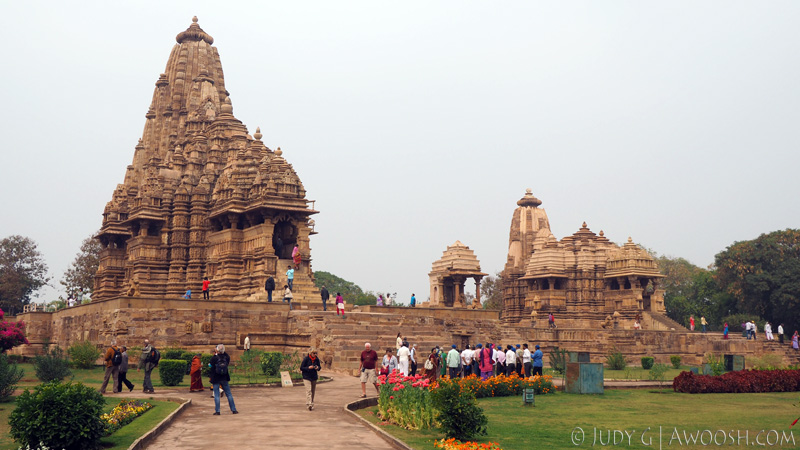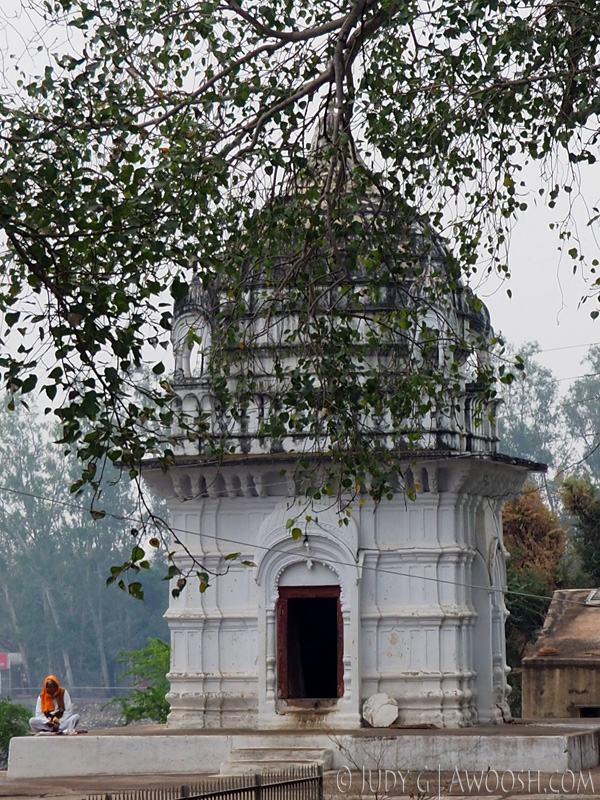As I mentioned in the first chapter of this saga, I have heard it opined that if you haven’t sh*t your pants, you haven’t really experienced India.
The same may be true about taking a train in India, which although less traumatic than fecal incontinence, can be an unsettling experience, especially if you need to use the super grotty loos ;^)
Trains and buses are the go to transport for the one billion plus people living in India. Flying is only for the wealthy, and for tourists in a hurry like us. The country is criss-crossed by roads and rails, and Indians are creative passengers – often climbing on the roof for a ride, when the vehicles are, as usual, chock-a-block full. Captain Safety is not on deck here…
So, as part of our Indian experience, Bonnie arranged one segment of travel between points on our tour to be done by train. The leg was from Agra, where we all were awed by the Taj Mahal and Red Fort, to Jhansi, a small city in the province of Madhya Pradesh, where we would detrain and board a new bus to take us to Khajuraho – the home of a stunning (and sexy!) complex of ancient Hindu temples.
Bonnie had forewarned us that the trains run on the India Stretchable Time model, and so we needed to be ready to wait. As it ended up, there was some sort of marathon planned for the morning of our train departure from Agra. Unlike the careful planning that usually goes into the marshalling of these races in western cities, there was apparently little to no warning that this race would go off, and that there would be significant road closures while it was being run. So Bonnie was left scrambling when our bus could not make the transit through the marathon route to pick us up at our hotel. Like magic, she conjured up another, herded us on to it, and got us to the station in time. Incredible!
Here is another reason why it is tough to travel around India without someone easing your way for you (ie going with a guide) – train tickets, which are much in demand, usually need to be purchased at least a few days ahead of travel. And in some of the more rural areas of India, women are apparently still not permitted to purchase their own tickets (hard to believe in the 21st century!), so that adds another layer of complication. Bonnie had managed to get almost our entire group booked into one ‘First Class’ car for the three hour journey from Agra to Jhansi. And, as predicted, the train was late coming to Agra, although not hugely so. When it stopped, there was sudden commotion – people getting off, people crowding to get on, and baggage being thrown off and on as well. Bonnie had arranged for porters to handle our group’s luggage, which was a good thing, as the crush of people and the super quick stop would have left some of us standing on the platform with our suitcases. As it was, one of my sisters (being the polite Canadian that she is) allowed the people around her who were pushing and shoving to get on ahead of her, and when the train started to move, she still had one foot on the platform!
If this is ‘first class’, I’d hate to see what it was like in the ‘third class’ cars on these trains. We were crammed in, but everyone apparently had a seat assignment, and that was a good thing. A young Indian guy spent the three hours staring unabashedly at my cute blond sister sitting beside me. It was a little disconcerting, but apparently not unusual in India.
The scenery from the train was a continuation of the kinds of views that we had being seeing driving by bus through the Indian countryside – across plains, over rivers, through rocky patches. You often see the seedy underside of towns and cities when you approach them by train, and India was no exception – slums flank the track in some places. You can’t avoid witnessing the squalor in which some poor souls are trying to survive.
The train made a few stops along the way, and then we jumped down on command at Jhansi, and boarded the new bus, that was to take us to Khajuraho.
Along the way, we made a stop for an archeological visit and lunch in a small town called Orchha. I think most of us kind of fell in love with this little country village. It was such a huge contrast from the dense traffic, and running the gauntlet of persistent vendors in places like Agra and Delhi. In Orchha, the locals were clearly curious about us westerners moseying though their town, but they did not accost us. And the site we visited, the Orchha Palace, was uncrowded and serene.
The Jahingar Muhal
The Jahingar Muhal was constructed in the 1600’s, by a Hindu leader of the area, in classical Mughal style. The story is that when Jahingar came to town, he admired the palace, and so Dev, the Hindu prince, gave it to him. Jahingar spent one night in the palace and then went off to war, and so the palace was abandoned, not to be inhabited again until English hunters in the area used it is a lodge in the 1800’s. I was not able to corroborate this story by research on the internet, so take it with a grain of salt ;^)
No matter what its history, this was a gorgeous place to visit. With the lack of tourist pressure (Orchha is pretty far off the beaten Golden Triangle track), we had some quiet time to explore – climbing the many steep stone stairways, walking on the balconies, gazing out at the views over the town.
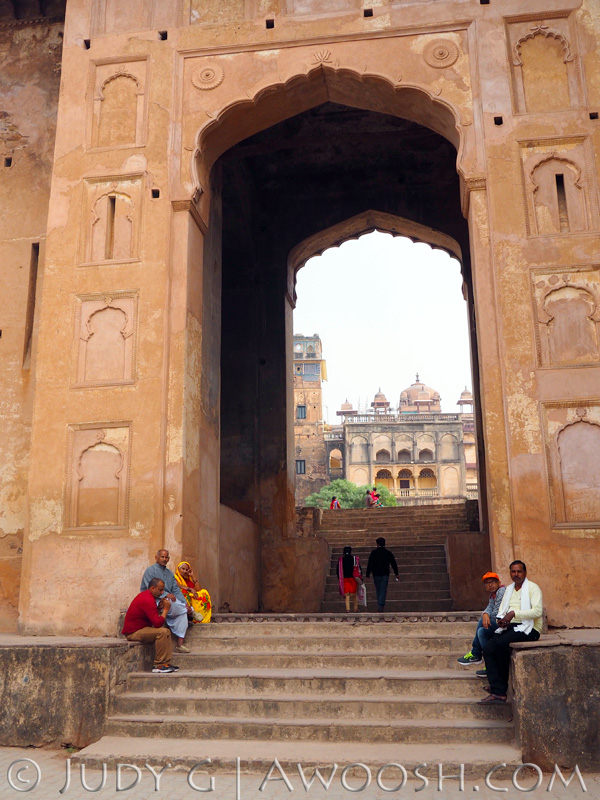
These decorative entry arches are a common theme in Mughal architecture. We saw them at all the mosques and Mughal palaces that we visited in India.
Back on the bus, we drove through the countryside, from Orchha to Khajuraho, where we would spend a couple of nights. On this leg of the journey, I finally scored a seat in the front, behind the driver, so I was a little more successful with the always challenging drive by shooting:

Also normal, in towns, cities, on highways. Indians will go to great lengths to avoid hitting these ‘holy cows’.
We arrived in Khajuraho late in the afternoon, settled in our rooms, and then went to chow down on (surprise!) some more great dal, garlic naan, and Kingfisher beer.
The Khajuraho Group of Monuments
The next morning we were up and raring to go to see the beautiful Hindu (and Jain) temple complex at Khajuraho. These sandstone temples predate the construction of the famous temples at Angkor Wat in Cambodia. It was suggested that both the building technology and the carving style were exported to Southeast Asia, where they were used to construct Angkor Wat, starting in the 1100’s.
The Khajuraho Group of Monuments is yet another UNESCO World Heritage site in India. The site is beautiful, expansive and not overly touristed.
There were originally many more temples at this location, on a much larger footprint, but with time they have disappeared, and what is left are these twenty temples, sitting on approximately six square kilometers. Most of the temples are dated between 950-1050 AD – so at least a century before Angkor Wat.
In fact, the entire site went undetected by the wider world for centuries, after the Moghuls occupied and controlled most of India and the temples fell into misuse. The structures, located in a sacred valley for the Hindus, were eventually completely covered with vines and other foliage. The story is that an English hunter happened upon the strange sight of numerous tall green hillocks in an otherwise pretty flat landscape, and took it upon himself to investigate. I can only imagine the incredible surprise he had when he peeled back the greenery and found some of these temples! And especially if he happened upon some of the more carnal carvings!
We had a great local guide for this portion of our trip, and he started by giving us a meaningful, twenty minute lecture on Hinduism. I managed to video portions of it, and if I ever figure out how to post it on Vimeo or Youtube, I have his kind permission to share it. But in short, what we learned was this:
Hinduism has over 3 million deities (you’ve got to wonder who the heck keeps track of all this stuff?). Hindu society is very heirarchal, with four castes. You are born into a caste, and can not rise above it in your lifetime, and certain types of occupations can only be held by people in certain castes. As an example, Hindu priests can only come from the Brahmins, or highest caste.
A cornerstone of Hindu faith is the concept of reincarnation. You may not be able to climb the social ladder in this life, but what you can do is lift yourself up in the next life by acts of kindness, compassion, and charity in this one. I like that idea.
Modern Indian laws suggest that the shunning of the Sudra (the ‘untouchables’) is no longer legally permitted, but we were told it is still alive and well in smaller, rural communities. To really understand how the caste system works, and what it means to people living in the different stratas of Indian society, I highly recommend reading ‘A Fine Balance’ by Rohinton Mistry. It’s a fantastic novel.
Another cornerstone of the Hindu culture is arranged marriage. We were told that in India today, the vast majority of Hindu brides are still married to men not chosen by them, and perhaps they will only meet their future husband once or twice (and always with chaperones!), before the wedding. Marriages are made strategically, between families, and often a dowry is involved. Once a woman is married, she goes to live with her husband’s family – who most often are total strangers to her!
Amazingly, the divorce rate is still very low in India. What the Hindus say is “love will grow”. And the Indian wedding is a thing to behold – no matter how modest the means, these are huge, colourful, noisy extravaganzas that go on all night long.
The structures at the Khajuraho Group of Monuments are a mixture of Hindu and Jain temples. Jains are a branch off from Hinduism, as is Buddhism, and Sikhism. It’s a bit complicated.
Hindu temples are generally devoted to three or four of the main deities. In the case of Khajuraho, most of the temples are devoted to Shiva and Vishnu.
So, moving on, I am going to share not only pictures of the temple complex, but some close ups of some of the more, er, fascinating scenes carved in sandstone. You have been warned ;^)
One of the four Hindu goals in life is Kama – which loosely described means passion, and passion naturally includes sex. And there sure are some very sexy carvings on some of the temples at Khajuraho. There are also carvings that (somewhat humorously) depict things like bestiality. I found it a bit ironic to see such graphic depictions of orgies, nudity (including the exaggerated naughty bits), and sex with animals in India, because when you travel around the country, you realize that Indians are generally very modest about showing any flesh, and are somewhat disapproving of tourists who don’t go along with the chaste dress code. Women in India mostly wear full body coverings in the form of colourful saris (although interestingly, it is totally acceptable to leave a bit of sexy midriff showing) – but knees, ankles and shoulders are never bare. Only a few younger woman can be seen in western clothing. Men wear mostly long pants, unless dressed in Gandhi-style traditional dothi. Truck drivers somehow manage to wash themselves on the roadside without showing much skin. Women, changing into swimming saris on the banks of the Ganges in Varanasi, manage to do it without so much as a flash of flesh. So bigtime nudity, on temples, is a bit of a dichotomy.

Ganesh (the Hindu elephant deity) has got it going on, while having a boo at what is happening next door ;^)

The girls in front of one of the twenty temples on the site. The carvings are truly extraordinary, and the fact that the sandstone has held up over a thousand years of weathering and infestation of vines etc, with so little damage is miraculous.
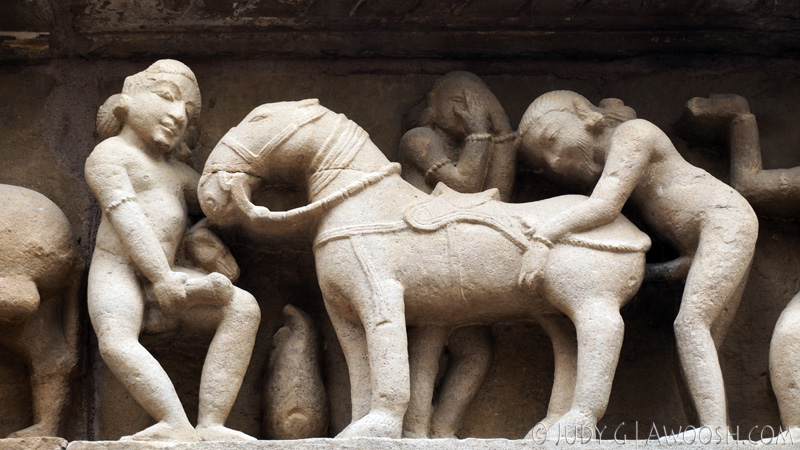
This scene is part of a large frieze that depicts men at war. Very naughty boys, and the horse does not look pleased ;^)

The interior of one of the temples devoted to Shiva. There was no lighting in the temples, but a lovely Hindu lady with a little flashlight led us through this temple, describing in broken English who the statues and carvings depicted, and chanting ‘Om Namah Shivaya’

At almost every tourist site we visited in India are at least one or two of these guys – dressed in the traditional attire, this guy is quietly begging.
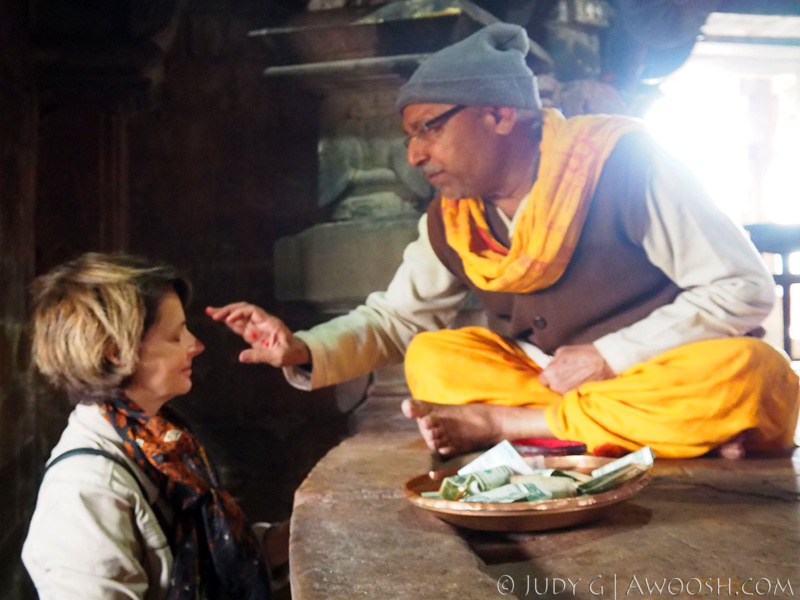
Before we left the site, we were offered the opportunity to receive a blessing from a Hindu priest. Here he is putting a bindi on my forehead, and after this, he will tie a red knotted string around my wrist. It is a prayer bracelet.
After the temple tour, followed by a visit to yet another local artisan centre, where local textiles, jewelry and art were for sale, we returned to the hotel, and for the first time on our trip, we were offered some ‘free time’.
The hotel where we stayed (Jass Radisson) had a spa, gym, and a (chilly!) outdoor pool. I swam in India when I had the chance, although the water took my breath away when I first dove in. We visited northern India in February – really, an excellent time to go. The weather was dry, but cool, so although sunny most days, we did not roast in the midday heat. The only thing is, given that most months of the year are hot and humid in India, they don’t have heaters for the outdoor pools at the hotels. Brrrr.
The two sisters decided to opt for a massage at the hotel spa and greatly enjoyed it. My friend and I decided to try out the Ayurvedic Massage on offer nearby. And what an experience that was!
I have been lucky to have quite a few massages on my dive travels. In places like Thailand, Indonesia, Philippines etc, they are offered up with varying levels of quality and serenity, but they are generally very budget-friendly, as was this one in India. I had my first real ‘Thai Massage’ this past January, where I was manipulated into challenging yoga poses to the point when I thought something was going to snap. Not enjoyable for me – I’ve decided to definitely stick to something less aggressive in future!
I really didn’t know much about Ayurveda before going to India, other than it is an ancient discipline of natural medicine and healing that came out of southwest India (Kerala province I believe). It was for sure something unique to try an Ayurvedic massage, in the countryside of India, and this is how it went down:
After selecting a therapeutic, herb-infused oil massage from the limited menu on offer, we were escorted into our own, modest, windowless rooms. Soft Indian tonal music was piped in from somewhere. The Indian massage therapist, a girl, clearly did not have a lot of English, but enough that we could communicate on a very basic level. She told me take off my clothes. Not so much on they’ll leave the room while you strip down to your nothings and then lie on the table face down and cover your naked arse with a warm blankie before they come back kind of thing. Just peel in front of her, and then stand there while she ties on a paper g-string that (inadequately) covers your naughty bits.
Now dear reader, you should know that I have birthed three babies, and through those rather inelegant but incredible experiences, I lost much of my modesty. But still, to drop my drawers in front of a total stranger and just stand there in my altogether was a bit outside the box for me.
The massage started by me being seated (did I mention pretty much butt naked?) on a stool, and then a vigorous head rub began. The oils were chosen for their medicinal qualities, not their aroma. I am not sure, but I think I might have smelled a bit like a salad when I was done ;^)
After the snappy head rub, she indicated that I should lie on my back on the table. Did I mention no blankie or sheet? Just me, laid out like a slab of beef (wearing the ever-inadequate paper g-string), with a white smocked young Indian lady lathering me up with herbal oils. After working on isolated muscle groups a bit, she started this amazing stroke – from fingertips to toes, up and down one whole side of my body at a time. It was awesome.
After flipping me over to work on my back (at which time she artfully whipped off the paper g-string so I really, truly was butt naked), she continued with the amazing therapy. After it was done, I was wrapped in a cloth, led to a dribbly shower that wasn’t all that effective in rinsing off the bucket of oil that had been applied, and dunked under it. Then I dried off as best I could, slithered back into my clothes, and went to the waiting room to drink a cup of herbal tea with the others, who were also just finished their massages. We all were glowing, and quietly raving about the experience. I’d do it again in a heartbeat.
In the next chapter – Learning and Burning in Varanasi – which is the last about India (yes, this thing is almost over!), we will be going on a crack o’ dawn mini-safari in a wild sanctuary near Khajuraho, in search of elusive tigers, and then flying to Varanasi, our last stop in India. Varanasi is the holiest city in India, and the destination of thousands and thousands of Indian pilgrims every year. Varanasi is located on the banks of the sacred Ganges River, where people cleanse their spirits by dousing themselves in the river at dawn, and where bodies are burned 24/7 on open pyres. It’s a crazy place.
You can find previous chapters of this serial blog about India by clicking the links below:
Chapter 1 – Just Say No to Delhi Belly
Chapter 2 – Walking in Gandhi’s Footsteps
Chapter 3 – Colliding Worlds in Jaipur
Chapter 4 – Agra & The Taj Mahal


